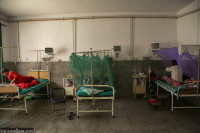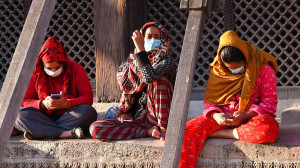Health
22 percent of Kathmanduites over 30 are diabetic
As the disease rises among young people, a new type-5, known as mid-point diabetes, has also appeared.
Post Report
As many as 22 percent of Kathmandu residents over 30 have high blood sugar, according to a preliminary report of a random blood sugar test carried out by the Kathmandu Metropolitan City around a year ago.
The figure is almost three times the estimated national average of eight percent, which doctors and public health experts say is alarming.
Of 19,660 people tested during the study, five percent were newly diagnosed with diabetes, while 14.5 percent said that they already had the disease. Officials also said another 2.4 percent of the population were found not taking medication despite knowing that they have high blood sugar levels.
“Though we don’t have data on population-level studies on diabetes, it is clear that the problem has been rising alarmingly in recent years,” said Dr Jyoti Bhattarai, senior endocrinologist. “The rise is seen across all age groups, but what concerns me most is that young people are increasingly affected, and many of whom are not even aware of it.”
Diabetes is a non-communicable disease, which develops when blood sugar levels are too high. It occurs either when the pancreas does not produce enough insulin, or when the body does not respond properly to insulin. The World Health Organisation says diabetes can impact people across all life stages, including childhood, the reproductive years, working age and older adulthood.
Health officials say that preliminary findings of health screening of the general population above 30 by the city office are alarming. They say health screening was conducted on 26,019 people in December 2024 and January 2025 at 256 locations in the metropolis, including 32 urban health promotion centres. Tests were carried out to check blood pressure levels, diabetes, behavioural risk factors—smoking and alcohol intake—and renal function.
“Due to various reasons, we have not yet analysed all the data,” said Dr Dibas Neupane, an official at the Health Department under the city office. “But the preliminary results show alarming rates of diabetes and other non-communicable diseases among Kathmandu residents.”
Along with the rise in type-1 and type-2 diabetes in general population experts say problems of new kind of diabetes, which they called mid-point diabetes, have also emerged of late as serious public health concern.
Type-1 diabetes is an autoimmune disease, in which the body's immune system destroys insulin producing cells in the pancreas. In this condition the body does not make insulin or produces insufficient insulin.
Type-2 diabetes is common type diabetes, where the body becomes resistant to insulin or pancreas doesn't make enough insulin.
Type-5 diabetes or mid-point diabetes is a recently identified condition related to chronic undernutrition. Doctors say patients appear lean and thin but suffer from insulin deficiency.
Doctors say people of all ages could be affected by diabetes. It increases the risk of damage to kidneys, nerves, heart and eyes. Changes in dietary patterns such as increased consumption of processed foods, sedentary lifestyles, and rising stress levels are among the main causes.
“Most patients seek treatment when complications arise, which is often too late,” said Dr Dipak Malla, senior endocrinologist at Bir Hospital. “Many people think that problems like diabetes start only in the older age, but the number of young people suffering from diabetes has been rising in recent years.”
Lack of physical inactivity, and increasing obesity in children and young people are also contributing to diabetes.
“Anyone could develop non-communicable diseases and diabetes. Those who consume processed foods in excess, do not exercise, and are obese are at high risk,” said Malla. “Such people must change their eating habits and start physical exercise. If problems are identified early, complications can be prevented.”
Experts recommend launching awareness drives against non-communicable diseases, sedentary lifestyle and eating habits.
Non-communicable diseases—hypertension, diabetes, renal disease, liver problems, heart problems, and cervical cancer, among others—have emerged as major killers in recent years, accounting for 73 percent of total deaths worldwide, according to the Global Burden of Disease 2021 study conducted by the US-based Institution for Health Metrics and Evaluation.




 8.12°C Kathmandu
8.12°C Kathmandu











%20(1).jpg&w=300&height=200)

